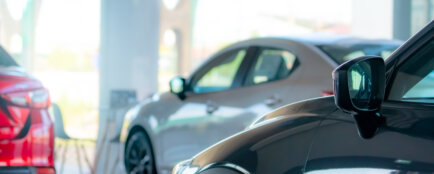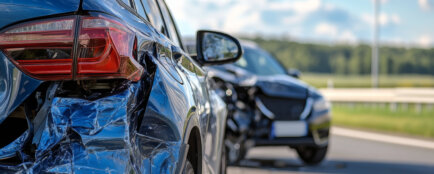What is commercial property?
Business assets include assets that the entrepreneur (self-employed person or company) keeps tax records or accounts for. If you claim flat rate expenses as a self-employed person, you don’t technically have any business property – and therefore can’t include a vehicle. In the case of a corporation (e.g. an LLC), business property is all the property owned by the company.
A vehicle can be included in the business assets, but it can also be removed from them – both have tax and record keeping implications.
A car is a business asset
There are several advantages to including a car in business assets, which can mean significant tax savings in the long run. The most significant is the ability to write off the purchase price of the car.
The car is classified as tangible property in the second depreciation group and can be depreciated over five years under the Income Tax Act. Depreciation is fully tax deductible, which means that it gradually reduces the tax base of the entrepreneur and spreads the cost of the car over several years.
Another significant advantage is the possibility of claiming the real costs of operating the vehicle. This means that you can include in your tax deductible expenses not only fuel, but also the cost of repairs, regular and emergency servicing, compulsory liability, accident insurance, purchase of accessories, seasonal tyre replacement, technical evaluation of the car, washing or parking.
Are you solving a similar problem?
Not sure how to do your taxes properly so you don't get it wrong?
We can help you navigate the law, whether it’s dealing with a specific tax situation, preparing for an audit by the tax authority or defending yourself in court.
I want to help
- When you order, you know what you will get and how much it will cost.
- We handle everything online or in person at one of our 6 offices.
- We handle 8 out of 10 requests within 2 working days.
- We have specialists for every field of law.
Disadvantages
As well as the tax advantages, the inclusion of a car in business assets brings with it several important obligations and potential disadvantages. One of these is the fact that if the car is sold, the proceeds from the sale become part of the tax base.
This means that if you decide to sell the car after a few years, the amount you receive for it is included in your income and subject to income tax. While you may be exempt from tax on a non-business car one year after you buy it, this benefit doesn’t apply here – even after five years of depreciation.
Another significant disadvantage is the obligation to keep a detailed logbook. The logbook serves as evidence in any tax audit and must contain precise details of each business trip – date, time, destination, purpose, route, mileage and odometer reading.
Without a properly maintained logbook, the tax authorities may question your costs associated with operating the vehicle and charge you tax. In practice, this means daily discipline and consistent recording of all data, or the use of electronic journey tracking systems.
The car is not a business asset
If you choose not to classify your car as business property, it will remain ‘private’, but you can still use it for business purposes. This method is used by many self-employed people who want to reduce the administrative burden or who are counting on selling their car in the future.
Advantages of this option
There are several practical advantages to this option. If you sell the car more than one year after it has been purchased, the profit from the sale is not subject to income tax, which can be financially very advantageous.
There’s also a significant benefit in terms of simpler administration – you don’t have to deal with accounting depreciation or complicated records of running costs.
Even though the vehicle is not registered as a company vehicle, you can still claim basic mileage and fuel reimbursement, just as employees do when travelling for work. The exception is if you leased the car and have claimed the lease payments as a tax-deductible expense in the past – in this case you cannot use the basic reimbursement and are only entitled to reimbursement for fuel.
Calculation of expenses
Expenses are calculated using the basic reimbursement rate, which for 2025 is CZK 5.80 per km. Fuel reimbursement can be added to this. Consumption is calculated by arithmetic average of the data in the technical certificate and the price per litre is based on the decree of the Ministry of Labour and Social Affairs.
For example, in 2025 the following prices can be applied:
- Petrol 95: 35,80 CZK/l
- Petrol 98: 40,50 CZK/l
- Diesel: 34.70 CZK/l
- Electricity: CZK 7.70/kWh
In case the real fuel prices are higher and you want to take this higher price into account, you have to prove it with receipts.
Disadvantages
If the car is not part of your business assets, you cannot claim the actual costs of running it. This means that you cannot include in your tax deductible expenses the cost of repairs and servicing, compulsory third party or breakdown insurance, the cost of washing, cleaning and other operational services, tyre replacement or other accessories, as well as, for example, motorway vignettes or parking. All these costs must be paid out of your own pocket as they cannot be claimed on your tax records.
Although it is possible to use the basic reimbursement of CZK 5.80 per kilometre of driving (in 2025) together with reimbursement for fuel consumed, in many cases this system may not cover the actual costs of running the vehicle. This is particularly the case for drivers who drive frequently in the city and have higher fuel consumption, for owners of older cars with frequent repairs or where there are additional costs associated with operation, such as insurance, assistance services or loan repayments.
It is also the case that you cannot depreciate the purchase price of such a car, as depreciation is only for tangible assets that are recorded in the accounting or tax records. Thus, the value of the car cannot be deducted from your tax base over time, which deprives you of the opportunity to reduce your tax liability over the long term.
Finally, even a car that is not a business asset is subject to road tax if used for business purposes (but only if it is over 12 tonnes).
Transport expenses – flat rate
The flat rate transport expense allows businesses to deduct a fixed amount of CZK 5,000 per calendar month per vehicle used exclusively for business purposes. This amount covers all the costs of running the car – i.e. fuel, insurance, servicing and wear and tear. The advantage is that you don’t need to document individual expenses or keep a logbook, which will make your accounting much easier.
The flat rate is the same for all road motor vehicles – whether it’s a car, van, bus or motorcycle. It does not depend on the engine size, age or fuel consumption of the vehicle. The only exceptions are agricultural and forestry tractors and work machines, which are not eligible for this scheme. The flat-rate is also not applicable to vehicles purchased under finance leases or to vehicles used on a loan basis – i.e. free of charge from a third party.
The flat rate can be applied to a maximum of three vehicles, and it does not have to be the vehicles owned and classified as business assets – the flat rate can also be applied to vehicles outside business assets or to leased vehicles. However, the key condition is that the vehicle in question must not be given to another person for use, for example, for private use by a family member or friend. Exceptions are employees on business trips or associates.
A flat rate transport allowance is therefore an ideal option for entrepreneurs who use the car for business only occasionally, for example for occasional business trips, purchasing materials or inspecting orders. If you calculate that your monthly car expenses (e.g. fuel and other running costs) do not exceed £5,000, then a flat rate is preferable – as you will not only save money, but also the time needed to record each journey and collect documents.
Another interesting option is the so-called reduced flat rate. If you also use your car for private purposes, you can apply a reduced flat rate of CZK 4,000 per month. However, this reduced rate can only be applied to one vehicle – other cars in the company must be used exclusively for business.
Are you solving a similar problem?
Planning to buy a car?
We will arrange the purchase or sale of any movable asset for you legally, without any ambiguities or kinks. You can sign in just 3 days.
I want to help
- When you order, you know what you will get and how much it will cost.
- We handle everything online or in person at one of our 6 offices.
- We handle 8 out of 10 requests within 2 working days.
- We have specialists for every field of law.
What else can be claimed in addition to the flat rate?
Expenses that can be claimed alongside the flat-rate transport expenses include the cost of repairs and routine maintenance of the vehicle, as well as insurance premiums – both compulsory liability and accident insurance. Tax depreciation of the vehicle, the cost of long-term parking or garage parking, rent for the use of the vehicle, motorway tolls and road tax can also be claimed. However, they must be demonstrably incurred to earn, secure and maintain business income.
If you use a reduced flat rate (CZK 4,000), other tax deductible costs must be reduced to 80% of their value, including depreciation, parking, insurance and servicing. The only exception to this is depreciation of the vehicle, which can be taken into account separately.
Expenditure on fuel cannot be claimed at the same time as the flat-rate expenditure, either according to actual consumption or according to the Decree price. Similarly, it is not possible to combine the flat-rate with the application of basic compensation for wear and tear (e.g. CZK 5.80/km). It is also prohibited to include short-term parking fees – for example, during a business trip – which would otherwise be an allowable expense under the real cost regime.
If you use a reduced flat rate, you cannot claim 20% of other expenses related to the operation of the car (e.g. servicing or insurance premiums, except for the depreciation already mentioned, which is deducted separately).
The flat-rate transport expense option is not entirely flexible. Once you have chosen this method, you must apply it throughout the calendar year, for a specific car. It is therefore not possible to switch from flat rate to actual expenditure or vice versa in the middle of the year. The flat rate is also reduced proportionately if you acquire or dispose of a vehicle during the year – you then only claim a pro-rata amount for the specific months you owned and used the car for business.
What’s the most rewarding?
The right scheme can bring you significant tax savings, but it can also save you time and hassle with administration. Let’s take a look at which approach pays off the most in which situation:
A car in a business property pays off when:
- you drive a lot (on the order of hundreds to thousands of miles per month),
- you have high running costs (frequent refuelling, servicing, insurance, parking),
- you are a VAT payer and you want to claim a deduction for the purchase price and operation,
- you don’t mind administration, including keeping a logbook and collecting documents,
- you don’t mind taxing the income from the sale of the car in the future.
A non-business car is worthwhile when:
- you use the car only occasionally for business, but mostly for personal use,
- you don’t want to deal with depreciation and classifying the car as an asset,
- you want to claim a lump sum for wear and tear (CZK/km) and reimbursement for petrol,
- you don’t need a VAT deduction,
- you plan to sell the car eventually and want to avoid taxation of the profit on the sale.
The flat-rate transport expense is worthwhile if:
- you don’t want to keep a logbook or collect receipts,
- you drive little or cheaply – operating costs up to about CZK 5,000 per month,
- you appreciate simplicity and predictability – a fixed amount each month,
- you are not subject to VAT or do not deal with its application,
- you have a car without a lease and in personal or company ownership.
Examples from life
Intensive use of the car: Incorporation into business assets
Peter is a building craftsman and drives daily to jobs all over the country. He drives over 3,000 miles a month, frequently pays for parking, repairs the car, changes tires, and fills up the tank several times a week. He bought the car for CZK 800 000 in cash and is a VAT payer.
Peter can write off the entire purchase price of the car over 5 years, deduct VAT on the purchase of the car and on all running costs, while claiming all real expenses – which is definitely worthwhile given his driving volume. He may have to keep a log book, but it will give him significant tax relief.
Occasional business trips: car outside business property
Jana is a freelance graphic designer. She does most of her work from home. She mainly uses her car privately, but once a week she drives to a meeting at a coworking space or a printer. She drives about 400 km a month for business.
Jana does not have to deal with the classification of the car as an asset or tax depreciation. She uses a mileage allowance (CZK 5.80/km) and adds fuel costs based on average consumption. She can thus claim tens of thousands of crowns a year as an expense without having to keep accounts or complicated records. And if she ever sells the car, she won’t have to pay income tax after a year of ownership.
Small operation, low cost: flat-rate transport expenses
Tomas is an IT specialist who runs his business while working. He uses the car only occasionally – once a month he drives to a client meeting, occasionally he drives to a training session. His monthly expenses do not exceed CZK 2,000. At the same time, he sometimes drives his children in the car to after-school clubs.
Tomáš can claim CZK 4 000 per month as a reduced flat rate without keeping a logbook – even if he only drives half of this amount per month. He avoids receipts, petrol tickets and consumption calculations. In addition, he can be sure that private use does not matter for one car.
Summary
When using a car in business, the entrepreneur can choose between three modes – to include it in business assets, to leave it outside, or to use a flat rate transport expense.
Inclusion in business assets allows depreciation and real expenses (fuel, servicing, insurance) to be claimed, which pays off with frequent use and high costs. The disadvantages are the need to keep a logbook and the taxation of any sale of the car.
A non-business car offers less paperwork and the advantage of tax exemption when sold after a year. Lump-sum mileage and fuel allowances apply, but actual operating expenses and purchase price cannot be deducted.
A flat rate transport expense (CZK 5,000 per month, or CZK 4,000 for private use) is the simplest option without the need to keep records. However, it cannot be combined with mileage and fuel allowances and can be used for a maximum of three vehicles used for business.




